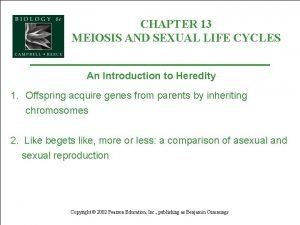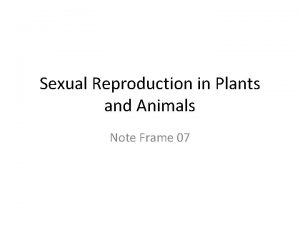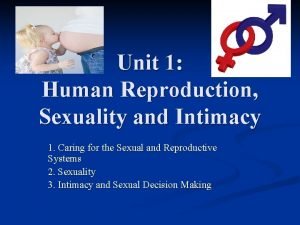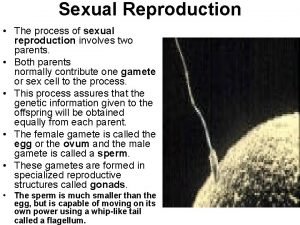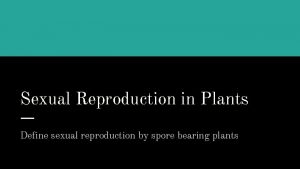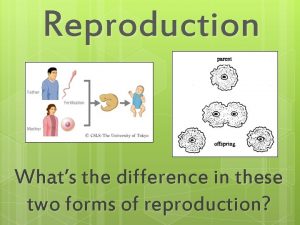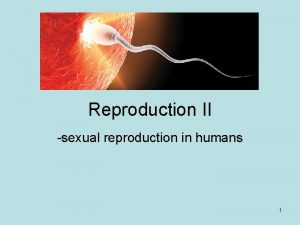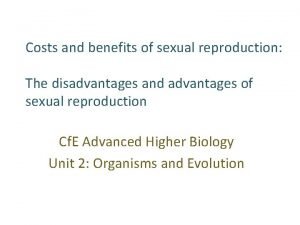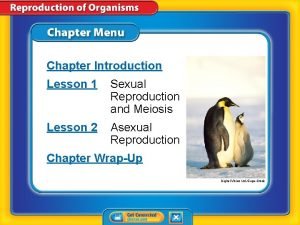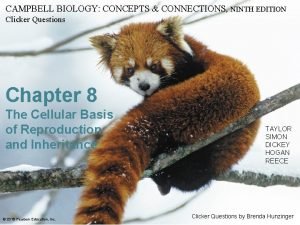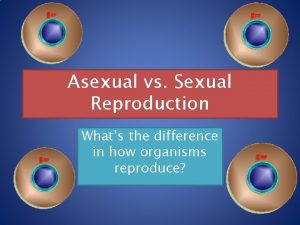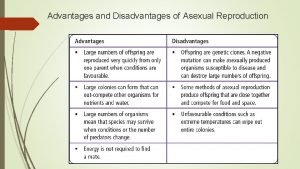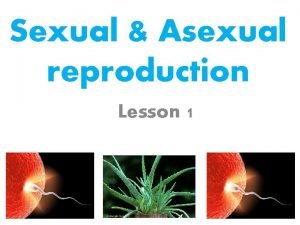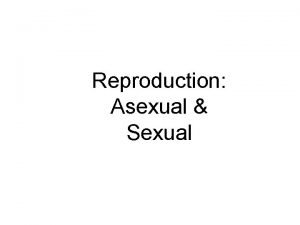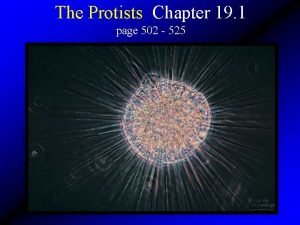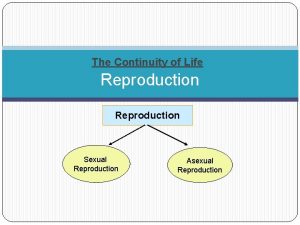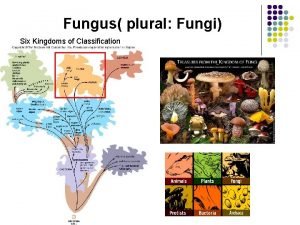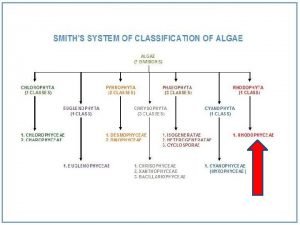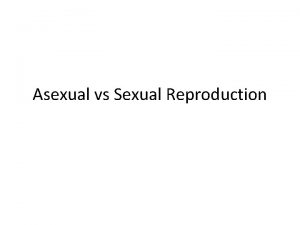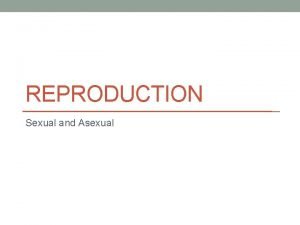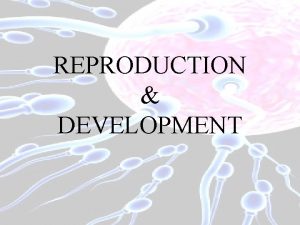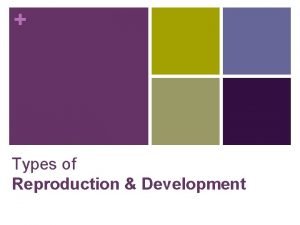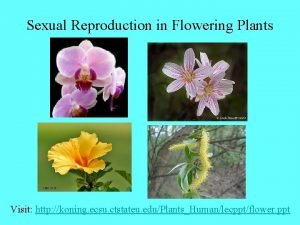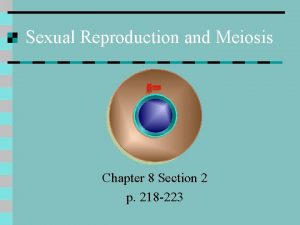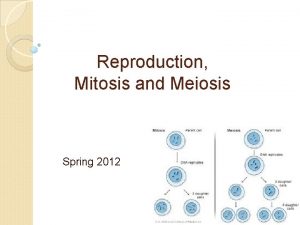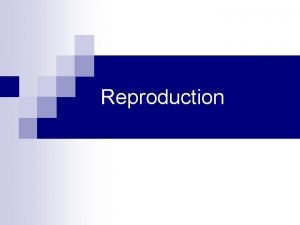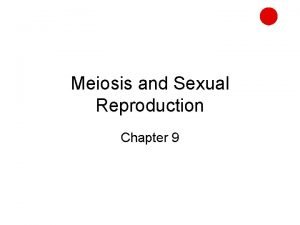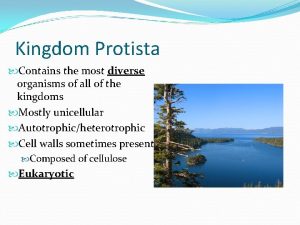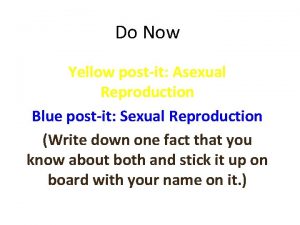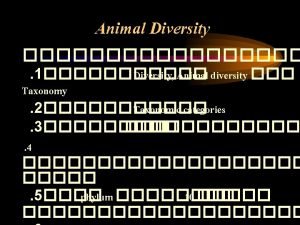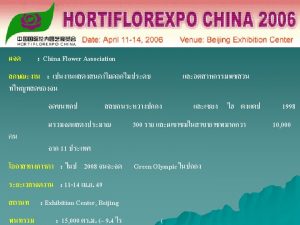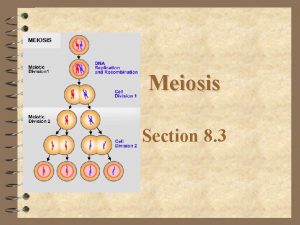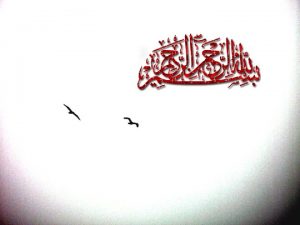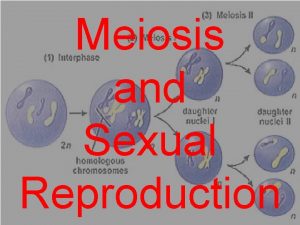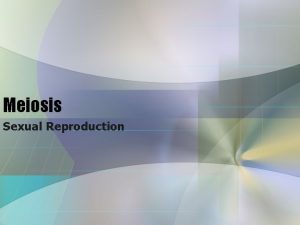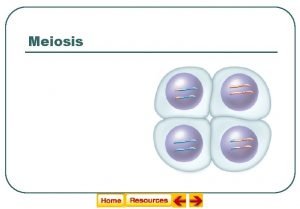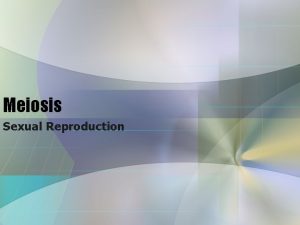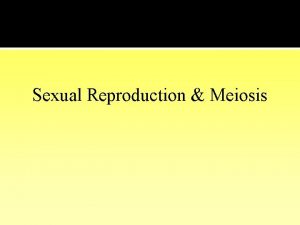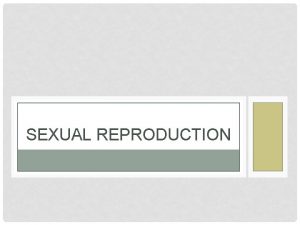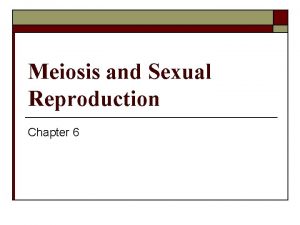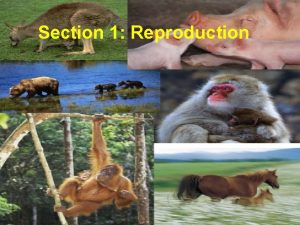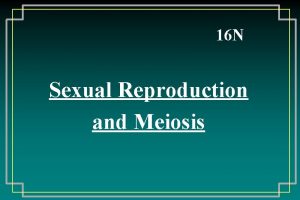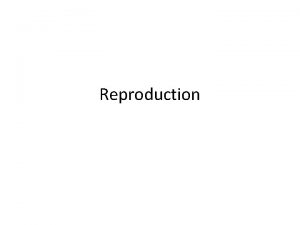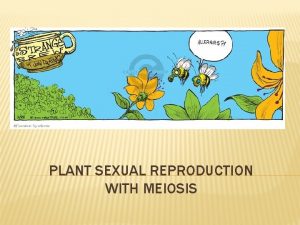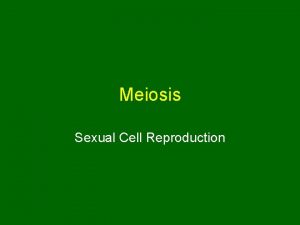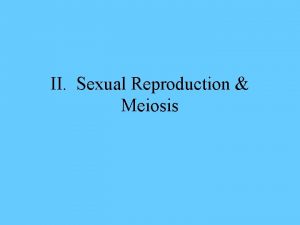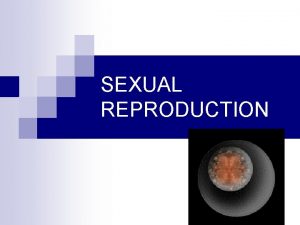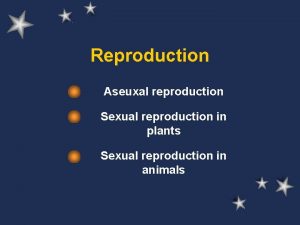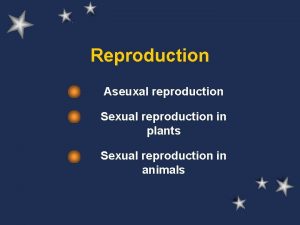Chapter 12 Meiosis and Sexual Reproduction 12 1

























































- Slides: 57

Chapter 12 Meiosis and Sexual Reproduction

12. 1 Why Sex? • In sexual reproduction, offspring arise from two parents and inherit genes from both • Asexual reproduction produces genetically identical copies of a parent (clones)

Advantages of Sexual Reproduction • An adaptive trait can spread more quickly through a sexually reproducing population than through an asexually reproducing one • Collectively, offspring of sexual reproducers have a better chance of surviving the effects of a harmful mutation that arises in the population

Sexual Reproduction in Animals and Plants

Meiosis and Sexual Reproduction • Sexual reproduction generates new combinations of traits in fewer generations than does asexual reproduction • The process inherent to sexual reproduction that gives rise to this variation is meiosis, a nuclear division mechanism that halves the chromosome number

12. 2 Meiosis Halves the Chromosome Number • Sexual reproduction mixes up alleles from two parents • Meiosis, the basis of sexual reproduction, is a nuclear division mechanism that occurs in immature reproductive cells of eukaryotes

Homologous Chromosomes • Somatic (body) cells of humans and other sexually reproducing organisms are diploid • One chromosome of each pair is maternal, and the other is paternal • Except for a pairing of nonidentical sex chromosomes, homologous chromosomes carry the same set of genes

Introducing Alleles • Genes are regions in an organism’s DNA that encode information about heritable traits • In sexual reproduction, pairs of genes are inherited on pairs of chromosomes, one maternal and one paternal • Alleles are different forms of the same gene • Offspring of sexual reproducers inherit new combinations of alleles, the basis of traits

A Corresponding colored patches in this fluorescence micrograph indicate corresponding DNA sequences in a homologous chromosome pair. These chromosomes carry the same set of genes. Figure 12 -2 a p 190

Genes occur in pairs on homologous chromosomes. The members of each pair of genes may be identical, or they may differ slightly, as alleles. B Homologous chromosomes carry the same series of genes, but the DNA sequence of any one of those genes might differ just a bit from that of its partner on the homologous chromosome. Figure 12 -2 b p 190

ANIMATED FIGURE: Genetic terms To play movie you must be in Slide Show Mode PC Users: Please wait for content to load, then click to play Mac Users: CLICK HERE

Gametes and Germ Cells • Sexual reproduction involves the fusion of reproductive cells (gametes) from two parents • In plants and animals, gametes form inside special reproductive structures or organs • Division of immature reproductive cells (germ cells) gives rise to gametes

Reproductive organs of a human male testis (where sperm originate) Figure 12 -3 a p 190

Reproductive organs of a human female ovary (where eggs develop) Figure 12 -3 b p 190

Reproductive organs of a flowering plant anther (where sexual spores that give rise to sperm cells form) ovary (where sexual spores that give rise to egg cells form) Figure 12 -3 c p 190

ANIMATED FIGURE: Reproductive organs To play movie you must be in Slide Show Mode PC Users: Please wait for content to load, then click to play Mac Users: CLICK HERE

What Meiosis Does • Meiosis in animal germ cells gives rise to eggs (female gametes) or sperm (male gametes) • Gametes have a single set of chromosomes, so they are haploid (n): Their chromosome number is half of the diploid (2 n) number • Meiosis of a human germ cell (2 n) produces gametes with 23 chromosomes: one of each pair (n)

Two Divisions in Meiosis • Meiosis partitions the chromosomes of one diploid nucleus (2 n) into four haploid (n) nuclei • In meiosis I, each duplicated homologous chromosome is separated from its partner • In meiosis II, sister chromatids are separated

Meiosis Halves the Chromosome Number B Homologous partners separate. The still-duplicated chromosomes are packaged into two new nuclei. A In meiosis I, each duplicated chromosome in the nucleus pairs with its homologous partner. C Sister chromatids separate in meiosis II. The now unduplicated chromosomes are packaged into four new nuclei. Stepped Art

Fertilization • The diploid chromosome number is restored at fertilization, when two haploid gametes (one egg and one sperm) fuse to form a zygote, the first cell of a new individual

Take-Home Message: Sexual Reproduction Increases Variation in Heritable Traits • Corresponding genes on homologous chromosomes vary in sequence as alleles • Alleles are the basis of traits; sexual reproduction mixes up alleles from two parents • Meiosis is the basis of sexual reproduction in eukaryotes; it precedes the formation of gametes or spores • Meiosis halves the diploid (2 n) chromosome number, to the haploid number (n); when two gametes fuse at fertilization, the chromosome number is restored; the zygote has one set of chromosomes from each parent

12. 3 Visual Tour of Meiosis • Meiosis halves the chromosome number • During meiosis, chromosomes of a diploid nucleus become distributed into four haploid nuclei

Summary of Steps in Meiosis

Meiosis I One diploid nucleus to two haploid nuclei 1 Prophase I. Homologous chromosomes condense, pair up, and swap segments. Spindle micro- tubules attach to them as the nuclear envelope breaks up. plasma membrane nuclear envelope breaking up 2 Metaphase I. The 3 Anaphase I. The homologous chromosome pairs chromosomes are aligned midway separate and begin between spindle poles. heading toward the spindle poles. 4 Telophase I. Two clusters of chromosomes reach the spindle poles. A new nuclear envelope forms around each cluster, so two haploid (n) nuclei form. spindle centrosome one pair of homologous chromosomes Stepped Art

Meiosis II Two haploid nuclei to four haploid nuclei 5 Prophase II. The chromosomes condense. Spindle microtubules attach to each sister chromatid as the nuclear envelope breaks up. 6 Metaphase II. The (still duplicated) chromosomes are aligned midway between poles of the spindle. 7 Anaphase II. All sister chromatids separate. The now unduplicated chromo somes head to the spindle poles. 8 Telophase II. A cluster of chromosomes reaches each spindle pole. A new nuclear envelope encloses each cluster, so four haploid (n) nuclei form. No DNA replication Stepped Art

3 D ANIMATION: Meiosis

Take-Home Message: What happens to a cell during meiosis? • During meiosis, the nucleus of a diploid (2 n) cell divides twice. • Four haploid (n) nuclei form, each with a full set of chromosomes—one of each type

ANIMATION: Meiosis I and II To play movie you must be in Slide Show Mode PC Users: Please wait for content to load, then click to play Mac Users: CLICK HERE

12. 4 How Meiosis Introduces Variation in Traits • Crossovers and the random sorting of chromosomes into gametes result in new combinations of traits among offspring • Along with fertilization, these events contribute to the variation among the offspring of sexually reproducing species

Crossing Over in Prophase I • Crossing over is the process by which a chromosome and its homologous partner exchange heritable information in corresponding segments • Crossing over occurs during condensation in prophase I

A Here, we focus on only two of the many genes on a chromosome. In this example, one gene has alleles A A and a; the other has alleles B and b. B Close contact between homologous chromosomes promotes crossing over between nonsister chromatids. Paternal and maternal chromatids exchange corresponding pieces. C Crossing over mixes up paternal and maternal alleles on homologous chromosomes. Stepped Art Figure 12 -6 p 194

ANIMATED FIGURE: Crossing over To play movie you must be in Slide Show Mode PC Users: Please wait for content to load, then click to play Mac Users: CLICK HERE

Chromosome Segregation • Homologous chromosomes can be attached to either spindle pole in prophase I, so each homologue can be packaged into either one of the two new nuclei • Random assortment produces 1023 (8, 388, 608) possible combinations of homologous chromosomes

1 The four possible alignments of three pairs of chromosomes in a nucleus at metaphase I. 2 Resulting combinations of maternal and paternal chromosomes in the two nuclei that form at telophase I. 3 Resulting combinations of maternal and paternal chromosomes in the four nuclei that form at telophase II. Eight different combinations are possible. Stepped Art Figure 12 -7 p 195

ANIMATED FIGURE: Random alignment To play movie you must be in Slide Show Mode PC Users: Please wait for content to load, then click to play Mac Users: CLICK HERE

Take-Home Message: How does meiosis introduce variation in combinations of traits? • Crossing over is recombination between nonsister chromatids of homologous chromosomes during prophase I; it makes new combinations of parental alleles • Homologous chromosomes can be attached to either spindle pole in prophase I, so each homologue can end up in either one of the two new nuclei

12. 5 From Gametes to Offspring • Aside from meiosis, the details of gamete formation and fertilization differ among plants and animals

Gamete Formation in Plants • Sporophytes • Diploid bodies with specialized structures that form spores (haploid cells) that give rise to gametophytes through mitosis • Gametophytes • A multicelled haploid body inside which one or more gametes form

mitosis multicelled sporophyte (2 n) zygote (2 n) Diploid Fertilization Meiosis Haploid gametes (n) spores (n) multicelled gametophyte (n) Figure 12 -8 a p 196

mitosis multicelled body (2 n) zygote (2 n) Diploid Fertilization Meiosis Haploid gametophyte (n) Figure 12 -8 b p 196

multicelled sporophyte (2 n) multicelled body (2 n) Figure 12 -8 c p 196

ANIMATED FIGURE: Generalized life cycles To play movie you must be in Slide Show Mode PC Users: Please wait for content to load, then click to play Mac Users: CLICK HERE

Gamete Formation in Animals • Males • Meiosis of primary spermatocytes produces four haploid spermatids, which mature into sperm • Females • Meiosis of a primary oocyte forms cells of different sizes; the secondary oocyte gets most of the cytoplasm and matures into an ovum (egg); other cells (polar bodies) get little cytoplasm and degenerate

Sperm Formation in Animals 2 3 4 1 male germ cell sperm Stepped Art

ANIMATED FIGURE: Sperm formation To play movie you must be in Slide Show Mode PC Users: Please wait for content to load, then click to play Mac Users: CLICK HERE

Egg Formation in Animals 5 6 7 egg female germ cell Stepped Art

ANIMATED FIGURE: Egg formation To play movie you must be in Slide Show Mode PC Users: Please wait for content to load, then click to play Mac Users: CLICK HERE

Fertilization • Chance combinations of maternal and paternal chromosomes through fertilization produce a unique combination of genetic information • Fertilization • The fusion of two haploid gametes (sperm and egg) resulting in a diploid zygote

Fertilization

Take-Home Message: How does meiosis fit into the life cycle of plants and animals? • Meiosis and cytoplasmic division precede the development of haploid gametes in animals and spores in plants • The union of two haploid gametes at fertilization results in a diploid zygote

12. 6 Mitosis and Meiosis – An Ancestral Connection? • Though they have different results, mitosis and meiosis are fundamentally similar processes • Meiosis may have evolved by the remodeling of existing mechanisms of mitosis

Comparing Mitosis and Meiosis I One diploid nucleus to two haploid nuclei Prophase I Anaphase I • Chromosomes condense. Telophase I • Homologous chromosomes pair. Metaphase I • Chromosome clusters arrive chromosomes • Crossovers occur (not shown). • Chromosomes align midway separate and move opposite spindle poles. • Spindle forms and attaches between spindle toward at spindle • New nuclear envelopes form. chromosomes to spindle poles. • Chromosomes decondense. poles. • Nuclear envelope breaks up. Stepped Art

Comparing Mitosis and Meiosis Mitosis One diploid nucleus to two diploid nuclei Prophase • Chromosomes condense. • Spindle forms and attaches chromosomes to spindle poles. • Nuclear envelope breaks up. Metaphase • Chromosomes align midway between spindle poles. Anaphase Telophase • Sister chromatids • Chromosome clusters arrive separate and move opposite spindle poles. toward at spindle • New nuclear envelopes form. poles. • Chromosomes decondense Stepped Art

Comparing Mitosis and Meiosis II Two haploid nuclei to four haploid nuclei Prophase II Metaphase II Anaphase II Telophase II • Chromosomes condense. • Chromosomes • Sister chromatids • Chromosome clusters arrive • Spindle forms and attaches align midway separate and move at spindle poles. chromosomes to spindle poles. between spindle toward opposite • New nuclear envelopes form. • Nuclear envelope breaks up. poles. spindle poles. • Chromosomes decondense. Stepped Art

Evidence in BRCA Genes • Molecular products of BRCA genes monitor and repair breaks in DNA, for example during DNA replication prior to mitosis • These same molecules monitor and fix breaks in homologous chromosomes during crossing over in prophase I of meiosis • Mutations that affect these molecules can affect the outcomes of both mitosis and meiosis • Sexual reproduction probably originated by mutations that affected mitosis

Mouse Cell Nuclei During Meiosis

Take-Home Message: Are the processes of mitosis and meiosis related? • Meiosis may have evolved by the remodeling of existing mechanisms of mitosis
 Asexualk
Asexualk Sexual reproduction and genetics section 1 meiosis
Sexual reproduction and genetics section 1 meiosis Sexual reproduction and genetics section 1 meiosis
Sexual reproduction and genetics section 1 meiosis Sexual reproduction vs asexual reproduction venn diagram
Sexual reproduction vs asexual reproduction venn diagram Sexual and asexual reproduction venn diagram
Sexual and asexual reproduction venn diagram Mendelian genetics
Mendelian genetics Chapter 10 sexual reproduction and genetics
Chapter 10 sexual reproduction and genetics Chapter 13: meiosis and sexual life cycles
Chapter 13: meiosis and sexual life cycles Chapter 13 meiosis and sexual life cycles
Chapter 13 meiosis and sexual life cycles Chapter 20 sexual reproduction in animals
Chapter 20 sexual reproduction in animals Crossing over occurs during:
Crossing over occurs during: Chapter 10 section 1 meiosis answer key
Chapter 10 section 1 meiosis answer key Chapter 10 meiosis 1 and meiosis 2 answer key
Chapter 10 meiosis 1 and meiosis 2 answer key Two types of reproduction
Two types of reproduction Venn diagram of meiosis and mitosis
Venn diagram of meiosis and mitosis Asexual vs sexual reproduction venn diagram
Asexual vs sexual reproduction venn diagram Asexual reproduction cell division
Asexual reproduction cell division Examples of reproduction
Examples of reproduction Asexual and sexual reproduction difference
Asexual and sexual reproduction difference Budding asexual reproduction
Budding asexual reproduction Organisms that reproduce asexually
Organisms that reproduce asexually Reproduction in humans
Reproduction in humans What is sexual reproduction
What is sexual reproduction Define sexual reproduction
Define sexual reproduction Whats a sexual reproduction
Whats a sexual reproduction Reproduction
Reproduction Parthenogenesis asexual reproduction
Parthenogenesis asexual reproduction Connecting the concepts sexual reproduction
Connecting the concepts sexual reproduction Solutions for campbell biology concepts & connections 8th
Solutions for campbell biology concepts & connections 8th Whats sexual reproduction
Whats sexual reproduction Disadvantages of sexual reproduction
Disadvantages of sexual reproduction Significance of sexual reproduction
Significance of sexual reproduction Asexual or sexual reproduction
Asexual or sexual reproduction Sexual reproduction in paramecia is called _____.
Sexual reproduction in paramecia is called _____. Sexual or asexual reproduction
Sexual or asexual reproduction Plural form of fungi
Plural form of fungi Division rhodophyta
Division rhodophyta Sexual or asexual reproduction
Sexual or asexual reproduction Reproduction
Reproduction Asexual or sexual reproduction
Asexual or sexual reproduction External fertilization
External fertilization Requires two parents
Requires two parents Sexual reproduction
Sexual reproduction Sexual reproduction
Sexual reproduction Mitosis definition
Mitosis definition Blastula
Blastula Algea
Algea Meiosis
Meiosis Most diverse kingdom
Most diverse kingdom Types of asexual reproduction
Types of asexual reproduction Anaphase in meiosis vs mitosis
Anaphase in meiosis vs mitosis The taxonomy of the domestic dog and humans
The taxonomy of the domestic dog and humans A sexual reproduction in plants
A sexual reproduction in plants Difference between meiosis 1 and meiosis 2
Difference between meiosis 1 and meiosis 2 Section 8-3 meiosis
Section 8-3 meiosis Meiosis 1
Meiosis 1 Oogensis
Oogensis Chapter 20 reproduction and pregnancy
Chapter 20 reproduction and pregnancy








